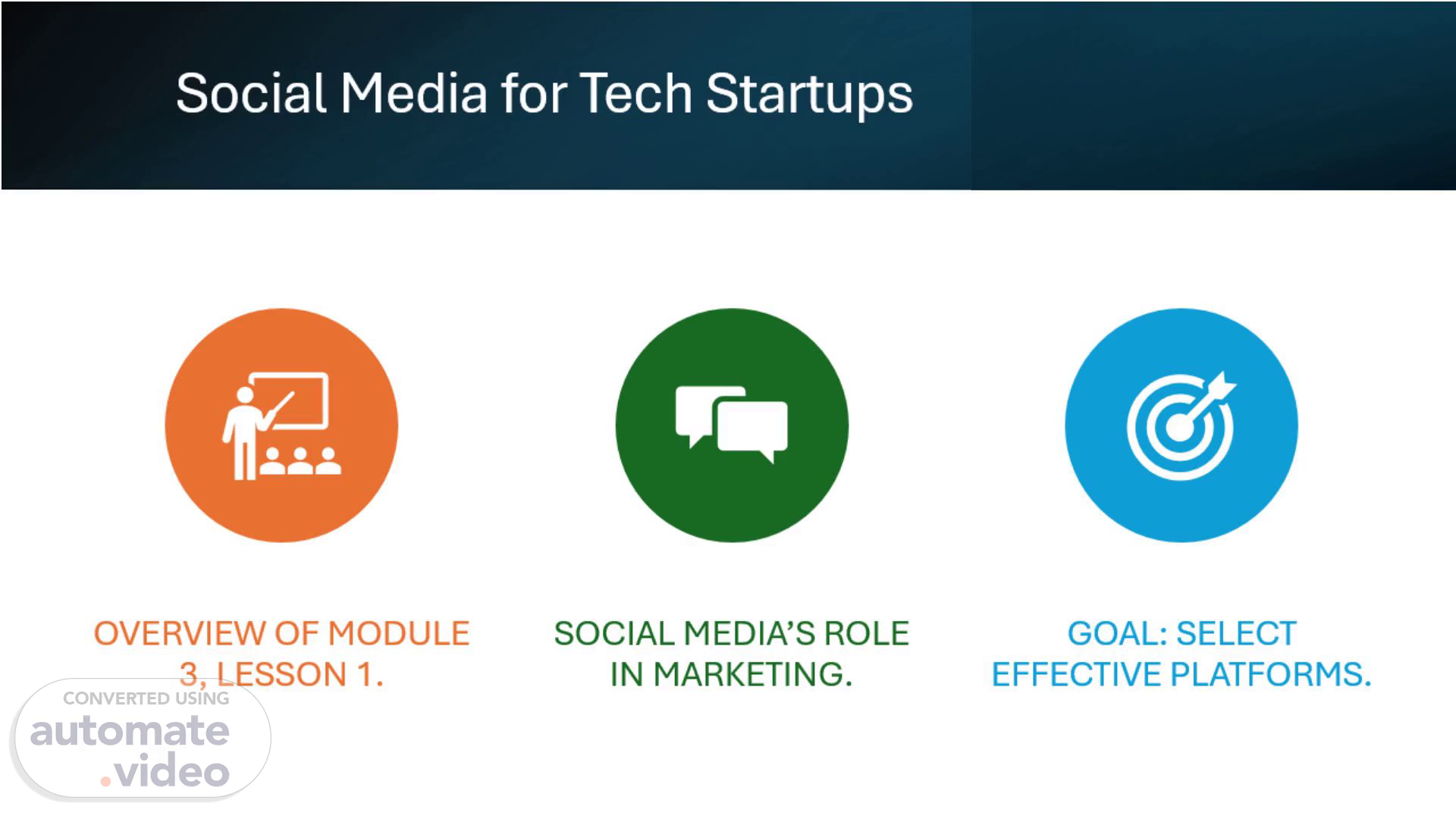Scene 1 (0s)
[Audio] Welcome back to DMT-201: Introduction to Digital Marketing for Tech Startups. I'm Robin Morris, and we're diving into Module 3, Lesson 1: Choosing the Right Social Platforms. You've built your website and content—now it's time to amplify your reach. Social media isn't just for selfies; for tech startups, it's a powerful tool to connect with buyers and build credibility. Today, we'll explore how to pick platforms that align with your goals. Let's get strategic..
Scene 2 (34s)
[Audio] The first rule of social media marketing is knowing your audience. Your tech buyers—IT leads, business owners—aren't on every platform equally. Are they professionals reading whitepapers on LinkedIn or developers swapping tips on niche forums? You need to meet them where they are, not scatter efforts across irrelevant channels. For a startup selling enterprise software, LinkedIn might beat Instagram every time. Focusing on the right platforms saves time and boosts impact..
Scene 3 (1m 3s)
[Audio] Each platform has unique strengths. LinkedIn excels for B2B, connecting you with decision-makers through posts or articles—perfect for a SaaS startup. Twitter, or X, is ideal for real-time updates, like 'New feature launched,' reaching tech-savvy followers fast. Reddit's subreddits, like those for startups or IT, let you engage niche communities for feedback—just don't sell too hard. Understanding these strengths helps you choose wisely..
Scene 4 (1m 36s)
[Audio] Resources matter—startups can't do it all. Posting daily on multiple platforms takes time, tools, and sometimes cash for design or ads. Pick one to master first based on your buyer and capacity. A small team might start with LinkedIn, aiming for two quality posts weekly. Measure what works—clicks, replies—before expanding. This lean approach keeps you effective without burnout..
Scene 5 (2m 3s)
[Audio] Content must fit the platform's vibe. Twitter demands short, punchy updates—'Cut downtime 20% with us' in 280 characters. LinkedIn supports longer thought leadership, like a 500-word post on industry trends. Reddit thrives on authentic discussion, not polished ads. Tailor your website content—like blogs or case studies—to each channel's style and audience habits. Mismatched content flops; alignment wins engagement..
Scene 6 (2m 36s)
[Audio] Your action: choose your platform. Where's your buyer active, and what can you manage? Download the Social Media Platform Comparison Chart from the Academy—it breaks down audience, effort, and use cases. Spend 10 minutes picking one—like LinkedIn for B2B—and plan two posts, like a stat and a question. That's Lesson 1 complete. Next, we'll dive into paid ads to supercharge your reach. See you in Lesson 2..
Scene 7 (3m 6s)
[Audio] Welcome back to DMT-201. I'm Robin Morris, and this is Module 3, Lesson 2: Intro to Paid Advertising. You've got social media humming—now let's talk paid ads to push your startup further. Organic reach takes time; ads get you in front of buyers fast. Whether it's Google or social platforms, paid advertising can drive leads and visibility with precision. Let's cover the essentials to start smart..
Scene 8 (3m 35s)
[Audio] Why bother with paid ads? They accelerate your marketing. Organic content builds slowly, but ads put you on buyers' screens now—crucial for startups needing quick wins. They let you target precisely, like IT pros searching 'data solutions' or managers on LinkedIn. Plus, you control the budget—start small, like $10 daily, and scale with results. It's a fast track to visibility and leads..
Scene 9 (4m 5s)
[Audio] Two platforms stand out for tech startups. Google Ads catch buyers actively searching—like 'best CRM software'—delivering your site to their results. LinkedIn Ads target professionals by job title or industry, ideal for B2B pitches like 'See Our Demo.' Each serves a purpose: Google for intent, LinkedIn for networking. Pick based on your goal—traffic or leads—and your buyer's habits..
Scene 10 (4m 32s)
[Audio] Good ads sell solutions, not features. 'Boost Efficiency 25%' beats 'New Software'—it's a benefit buyers grasp. Include a strong call-to-action, like 'Start Your Trial' or 'Learn More,' to prompt clicks. Start simple, then test—swap headlines or images to see what pulls better results. A fintech startup might test 'Save Time Now' versus 'Cut Costs Today.' Precision and iteration make ads work..
Scene 11 (5m 7s)
[Audio] Budgeting is key—start small. Try $50 over a week, targeting a specific keyword or group, and track return on investment. Did 10 clicks turn into 2 leads? That's data to adjust—tweak audience or spend. A startup might find $5 daily on Google Ads nets a client monthly, worth $500. Scale up when you see profit, not guesses. It's about testing, learning, and growing smart..
Scene 12 (5m 35s)
[Audio] Your action: plan a paid ad campaign. Pick a platform—Google or LinkedIn—and a small budget, like $20. Download the Ad Campaign Planning Template from The Academy to outline your goal, target, and CTA in 10 minutes. Example: '$10 on LinkedIn for 5 demo clicks.' This sets you up to test and learn. That's Lesson 2 done! In Module 4, we'll track and optimize your efforts. Catch you there..
